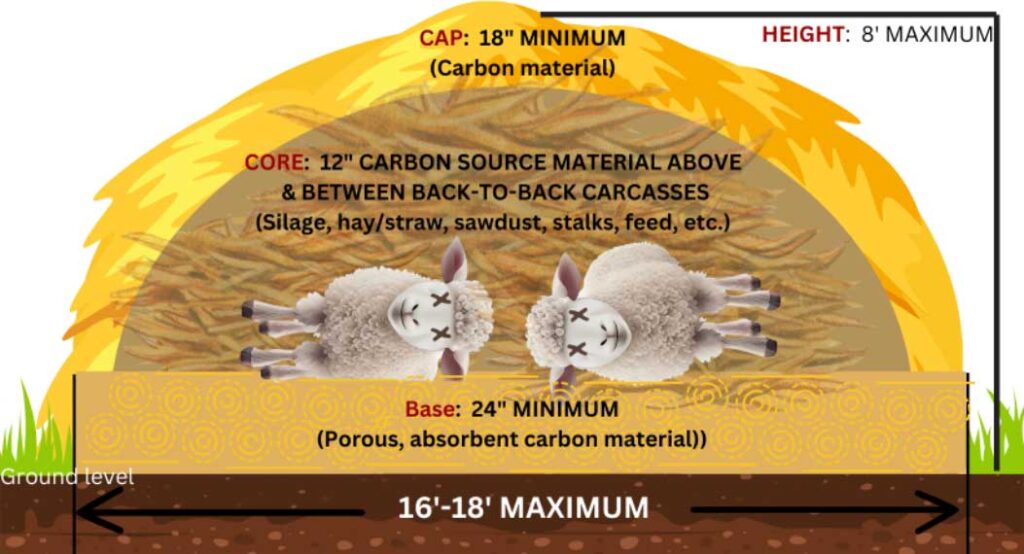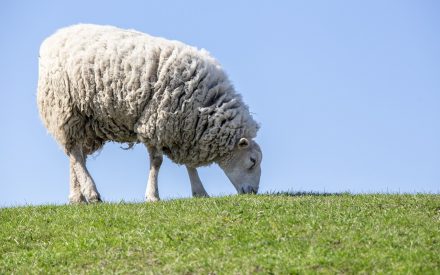Originally published in the ISIA December 2023 Newsletter
You have probably all heard the saying, “If you have livestock, you have deadstock.”
And what about this one, “A sick sheep is a dead sheep”?
I may tend to argue the second quote, and that could be another article for another day. Looking closer at these two statements, they might translate to say, “A sheep will find some way to die with little to no warning and probably an hour before you need to head out of town.”

Do you have a plan and the necessary materials to dispose of the carcass quickly and efficiently to reduce risk to your flock and neighboring flocks? If you answered “yes,” please scan for a quick reminder. If “no” or “I don’t know,” please take a few uninterrupted minutes to read and create a plan.
The Iowa Department of Natural Resources (Iowa DNR) lists five acceptable options for the disposal of dead animals: rendering, landfill, burning/incineration, composting, and burial. No matter which method is used, it is required that the animal be disposed of as soon as reasonably possible, generally within 24 hours. Each method has pros and cons and specific criteria to follow. Each should be evaluated to determine the most suitable way for each farm. Due to various costs, restrictions, and limitations associated with rendering, landfills, burning/incineration, and burial, many producers may find composting the most viable option.
Do you have a plan and the necessary materials to dispose of the carcass quickly and efficiently to reduce risk to your flock and neighboring flocks?
A predetermined composting site and readily available materials make disposing of expected farm mortalities relatively quick and easy. The Iowa DNR requires the composting site location to be at least:
- Five hundred feet from an inhabited residence.
- Two hundred feet from public wells.
- One hundred feet from private wells.
- Fifty feet from property lines.
- One hundred feet from flowing or intermittent streams, lakes, or ponds.
- Outside of wetlands.
- Outside 100-year flood plain.
Locate the composting site on all-weather surfaces of compacted soil or granular aggregates, asphalt, concrete, or other similarly impermeable material (Iowa DNR, 2023). The compost pile or windrow is placed on top of the suitable surface, starting with a base layer. The base layer must be constructed from a 24” layer of porous and absorbent carbon material. The material’s porosity allows oxygen to flow to the microbes, and the absorbent characteristic absorbs liquids from the decaying carcass to prevent runoff or leaching. The mortality is then placed upon the base layer and covered with at least 12 inches of carbon source materials, known as the core. The carbon source (bulking material) can be corn silage, wood chips, hay/ straw, or ground corn stalks. The sides of the core should extend past the mortality length to ensure all carcass areas are covered with at least 12 inches of bulking material. If multiple carcasses are composted simultaneously, 12 inches of carbon source material should be placed between each carcass. Small carcasses may be layered. A carbon-material cap is placed on top of the core. The cap helps retain heat and absorb odor and excess precipitation. The cap should be constructed from 18 inches of corn silage, wood chips, hay/ straw, or ground corn stalks. Eight feet is the maximum recommended height for the windrow pile for efficient compositing and ease of turning. The windrow or pile should be no more than 16 – 18 feet wide for adequate oxygen exchange.

Composting mortalities is the decomposition of a nitrogenous nutrient source (the mortality) by aerobic bacteria (bacteria that thrive in the presence of oxygen) using a carbon-based energy source to cover the mortality to decrease odor, allow for gas exchange, and absorb liquids. The balance of carbon and nitrogen (C:N ratio), oxygen, moisture, and temperature combine to create an environment ideal for the decomposition of the mortality to a stable state that can then be used as a soil amendment after decomposition has occurred. The recommended C:N ratio range is 15:1 to 40:1. Typical on-farm composting materials and their C:N ratios can be found in Table 1. When the compost structure is created, the carcass breaks down to release the nitrogen source for the bacteria.
| Carbon Source (Bulking Material) | C:N Ratio |
| Sawdust | 442:1 |
| Softwood shavings | 641:1 |
| Hardwood shavings | 561:1 |
| Hay- general | 15 – 32:1 |
| Wheat straw | 127:1 |
| Finished compost | 30 – 50:1 |
| Grass clippings | 17:1 |
| Leaves | 54:1 |
NRAES On Farm Compostion Manual (1992).
When metabolizing the nitrogen source, the aerobic bacteria and microorganisms release heat. The compost pile’s temperature should be measured/monitored to manage the process and determine when the pile needs to be turned and when the process is complete. Turning the compost pile mechanically disturbs the carcass and replenishes oxygen. The compost pile’s temperature should be measured every few days. The goal is to reach an internal temperature of 131 °F for at least three consecutive days to destroy most pathogens. When the temperature drops below 100 °F for more than one week, turn the pile and repeat the process. Only larger brittle bones will remain once the mortality has been adequately composted. The bones can then be buried, and the composting materials can be used as a soil amendment. (Note: During the cold winter months, the decomposition process will not begin until ambient temperatures have risen and microbial activity has resumed.)
Proper animal disposal practices are another step in maintaining a sound biosecurity plan. The Iowa Department of Land Stewardship (IDALS), the Iowa DNR, and the United States Department of Agriculture Animal and Plant Health Inspection Services (USDA APHIS) are all great places to visit to increase your knowledge of biosecurity and proper animal disposal. The Secure Sheep and Wool Supply Plan and Sheep Biosecurity from the Center for Food Security and Public Health are wonderful resources for planning and implementing individualized biosecurity plans.
Resources and More information
Brodie, H. & Carr, L. Composting animal mortalities on the farm. FS 717 layout (umd.edu)
The Center for Food Security & Public Health. (2004 – 2023). Farm biosecurity. https://www.cfsph.iastate.edu/biosecurity/#filter=.sheep_biosecurity
Cornell Waste Management Institute. Natural Rendering: Composting livestock mortality and butcher waste. Natural Rendering: Composting Livestock Mortality (wi.gov)
Iowa Department of Agriculture & Land Stewardship. Biosecurity. (2023). https://www.iowadnr.gov/Environmental-Protection/Animal-Feeding-Operations/Dead-Animal-Disposal
Iowa Department of Natural Resources. Dead animal disposal. https://www.iowadnr.gov/Environmental-Protection/Animal-Feeding-Operations/Dead-Animal-Disposal
Iowa Legislature. IAC 8/31/16 Environmental Protection [567] Chapter 105. https://www.legis.iowa.gov/docs/iac/rule/08-31-2016.567.105.6.pdf
Rozeboom, D. (2015). Carcass composting – A guide to mortality management on Michigan cattle farms. https://www.canr.msu.edu/resources/carcass_composting_a_guide_to_mortality_management_on_michigan_cattle_farms#:~:text=For%20composting%20whole%20carcasses%2C%20the,start%20of%20the%20composting%20process
Secure Sheep and Wool Supply. (2023). SSWS plan for continuity of business. https://securesheepwool.org/
United States Department of Agriculture, Animal and Plant Health Inspection Service. Biosecurity for sheep and goat producers. https://www.aphis.usda.gov/aphis/ourfocus/animalhealth/sa_animal_disease_information/sheep-goat/biosecurity



 Easy in, easy out: Incorporate biosecurity upon the introduction of new animals
Easy in, easy out: Incorporate biosecurity upon the introduction of new animals New Sheep Operation Enterprise Budget Tool available for farmers
New Sheep Operation Enterprise Budget Tool available for farmers Grazing Practices for Sheep and Flocks - 2020 Small Ruminant Webinar Series
Grazing Practices for Sheep and Flocks - 2020 Small Ruminant Webinar Series Small Ruminant Health - 2020 Small Ruminant Webinar Series
Small Ruminant Health - 2020 Small Ruminant Webinar Series


